Terrafugia’s transition
The most significant effort in the creation of a ‘Flying Car’ is by a company called ‘Terrafugia’ set up by MIT graduates in Massachusetts in 2006. But this one is a ‘Roadable Aircraft’ called ‘Transition’.
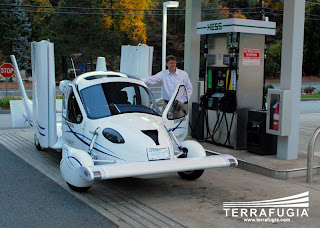
There are no bolts and nothing to put together or dismantle but you’d need to be a driver as well as a pilot to be able to use one of these. Terrafugia hopes to launch its first commercial model in 2011 and has already received 70 orders as of September 2009. This one will be a two-seater, which can travel 725 km at a speed of about 115 km/hr in air.
Moller International’s Skycar
Paul Moller’s invention is the ‘Skycar’ – a personal Vertical Take Off and Landing (VTOL) 4-seat aircraft which, uses four pairs of Wankel Rotary engines, and, it is claimed, can hover 15 feet above the ground. It has four ducted fans with covered propellers to increase safety.
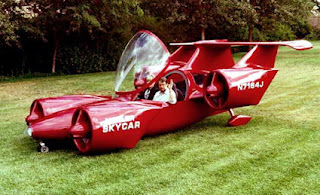
This ‘flying car’ has been several decades in the making and Moller has had to postpone projections of its launch more than twice. The present craft under production is the M400 which is planned in single as well as 6-seat versions.
Parajet Skycar
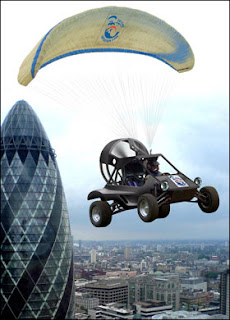
The Parajet Skycar actually flew and drove its way from London to Timbuktu in January 2009 without a hitch and has been declared the world’s first legal flying car. It has a top speed of 180 kmph and a maximum range of 400 kilometres. The car is basically constructed from a dune buggy combined with a paramotor (one of those paragliding contraptions which have a set of motorized propellers at the pilot’s back) for greater thrust and propulsion and a parafoil (the flat sail of a paraglider) to increase the lift.
Labiche’s FSC-1
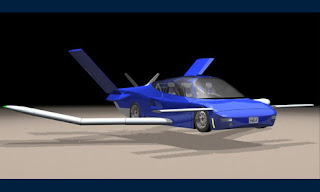
Mitch Labiche’s Labiche Aerospace has designed the FSC-1 which is basically a car that can open out into an aeroplane with the push of a button, or conversely, an aeroplane that can fold up to become a car.
Aquada
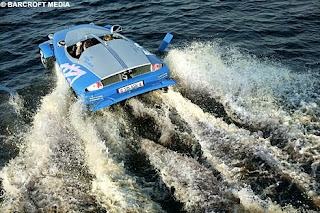
Using High Speed Amphibian technology (HAS), Gibbs Technologies led by Alan Gibbs has launched the Aquada in the USA. The HAS is a technology that has been developed over a period of seven years and can now even be applied to vehicles weighing up to 10 tons. The Aquada can travel at a maximum speed of 160 kmph on land and of about 49 kmph on water.
Once it enters the water, the wheels can be retracted, like in an airplane, thus significantly reducing the drag. With the press of a button, the wheels retract the car senses it is in water, activates the jet to propel it in water and changes the headlights into marine lights. It is buoyant and cannot sink.
The Skybike

Samson Motorworks’ Skybike is a three wheeled motorcycle that can be flown or driven on the streets with equal efficiency. Led by Sam Bousfield, an inventor with several patents to his name, this Sacramento- based company hopes to launch a radio-controlled model of its attractively titled ‘Switchblade’ flying bike up for display in a few months.
Hoverpod

Entecho, an Australian company has combined a new rotor technology with unique lifting surfaces to create a flying machine that looks like a typical flying saucer. A centrifugal fan causes the air under the car to move radially from the center towards the outside, generating lift as the ‘skirt’ – the airtight flexible membrane beneath the level of the rotor – blows up, directing the flow of the air downwards.
Air Car
In an extraordinary tie-up with Luxembourg based MDI (Motor Development International), Tata Motors (India) has been working hard for the last two years, to put the finishing touches to a technology that will enable their cars to run on air.
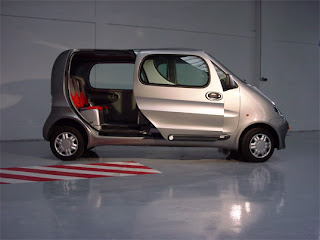
While these cars are all set to hit the roads of France by 2011, it’s their features that make you sit up and pay attention. Compressed Air cars usually use a motor powered by compressed air – or combine them with gasoline, diesel, electric or ethanol engines – to help gain higher speeds. France’s MDI plans several such hybrids to tide over this bug.
Tata’s vehicle, called the ‘Minicat’, is purely run on an air-compression engine, is a zero-emission vehicle and might even be launched this year, as the first batch has already completed production at its Uttarakhand factory in Pantnagar. The company claims that the vehicle can reach a speed of 96 kilometres per hour and cover a range of 300 kilometres on a full tank of air.
No comments:
Post a Comment